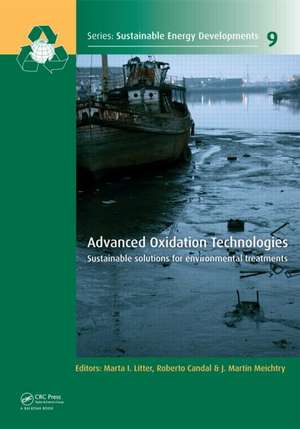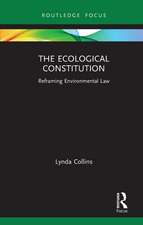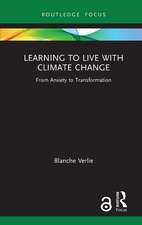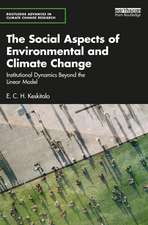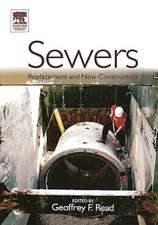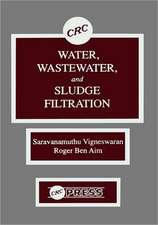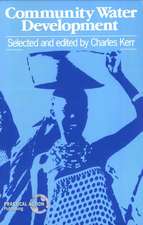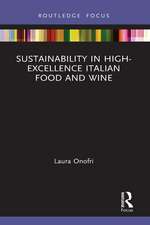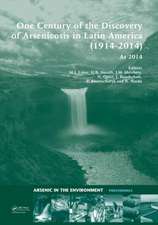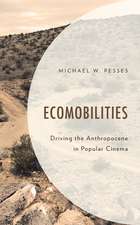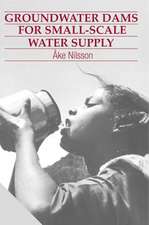Advanced Oxidation Technologies: Sustainable Solutions for Environmental Treatments: Sustainable Energy Developments
Editat de Marta I. Litter, Roberto J. Candal, J. Martin Meichtryen Limba Engleză Hardback – 3 mar 2014
This book provides a state-of-the-art overview on environmental applications of Advanced Oxidation Technologies (AOTs) as sustainable, low-cost and low-energy consuming treatments for water, air, and soil. It includes information on innovative research and development on TiO2 photocatalytic redox processes, Fenton, Photo-Fenton processes, zerovalent iron technology, and others, highlighting possible applications of AOTs in both developing and industrialized countries around the world in the framework of “A crosscutting and comprehensive look at environmental problems”.
The book is aimed at professionals and academics worldwide, working in the areas of water resources, water supply, environmental protection, and will be a useful information source for decision and policy makers and other stakeholders working on solutions for environmental problems.
Preț: 1411.37 lei
Preț vechi: 1973.53 lei
-28% Nou
Puncte Express: 2117
Preț estimativ în valută:
270.10€ • 280.95$ • 222.98£
270.10€ • 280.95$ • 222.98£
Carte tipărită la comandă
Livrare economică 14-28 aprilie
Preluare comenzi: 021 569.72.76
Specificații
ISBN-13: 9781138001275
ISBN-10: 1138001279
Pagini: 350
Dimensiuni: 174 x 246 x 25 mm
Greutate: 0.84 kg
Ediția:New.
Editura: CRC Press
Colecția CRC Press
Seria Sustainable Energy Developments
ISBN-10: 1138001279
Pagini: 350
Dimensiuni: 174 x 246 x 25 mm
Greutate: 0.84 kg
Ediția:New.
Editura: CRC Press
Colecția CRC Press
Seria Sustainable Energy Developments
Public țintă
PostgraduateCuprins
1. Decontamination of water by solar irradiation 2. Reduction of pentavalent and trivalent arsenic by TiO2-photocatalysis: An innovative way of arsenic removal 3. Synthesis, characterization and catalytic evaluation of tungstophosphoric acid immobilized onY zeolite 4. Kinetic aspects of the photodegradation of phenolic and lactonic biocides under natural and artificial conditions 5. Fenton-like oxidation of phenol with a Cu-chitosan/Al2O3 catalyst in a recirculating batch reactor 6. Degradation of a mixture of glyphosate and 2,4-D in water solution employing the UV/H2O2 process, including toxicity evaluation 7. Degradation of perchlorate dissolved in water by a combined application of ion exchange resin and zerovalent iron nanoparticles 8. Eco-friendly approach for Direct Blue 273 removal from an aqueous medium 9. Decontamination of commercial chlorpyrifos in water using the UV/H2O2 process 10. Abatement of nitrate in drinking water. A comparative study of photocatalytic and conventional catalytic technologies 11. Photocatalytic inactivation of airborne microorganisms. Performance of different TiO2 coatings 12. Water decontamination by heterogeneous photo-Fenton processes over iron, iron minerals and iron-modified clays 13. Modified montmorillonite in photo-Fenton and adsorption processes 14. Photocatalytic degradation of dichlorvos solution using TiO2-supported ZSM-11 zeolite 15. Water disinfection with UVC and/or chemical inactivation. Mechanistic differences, implications and consequences 16. Ag/AgCl composite material: synthesis, characterization and application in treating wastewater 17. Highly photoactive Er3+-TiO2 system by means of up-conversion and electronic cooperative mechanism 18. Stabilized TiO2 nanoparticles on clay minerals for air and water treatment 19. Photodegradation of beta-blockers in water 20. Final conclusions
Notă biografică
Professor Marta I. Litter was born in BuenosAires,Argentina. She holds a degree and a Doctorate in Chemistry from the University of Buenos Aires, Argentina. She performed a Postdoctoral stage at the University of Arizona, USA, in Polymer Chemistry (1983). She is the Head of Remediation Technologies Division, National Atomic Energy Commission, Argentina, Principal Researcher, National Research Council (CONICET,Argentina) and Full Professor of the University of General San Martín, Argentina. She has written more than 150 scientific publications. She has coordinated several projects on water treatment, mainly in Advanced Oxidation Technologies. She was also Coordinator of the CYTED IBEROARSEN Network (2006–2009).
She received the Mercosur Prize 2006 in Science and Technology, Technologies for Social Inclusion, for the Project: “Potabilization of water by low-cost technologies in isolated rural zones of Mercosur” and the Mercosur Prize 2011 in Science and Technology, Technologies for Sustainable Development, for the Project: “The problem of arsenic in the Mercosur.An integrated and multidisciplinary approach to contribute to its resolution.”
At present she is President of the Local Organizing Committee of the 5th International Congress on Arsenic in the Environment (As2014) to be held in Buenos Aires, Argentina, from 11 to 16 May 2014.
Professor Roberto J. Candal, born 1960 in Argentina, holds a degree in Chemistry and a doctorate in the field of Inorganic Chemistry from the University of Buenos Aires. He held a three year position as Post-doc at the Water Chemistry Laboratory, University of Wisconsin, Madison WI, USA. His interests in research are focused on the development of newmaterials with application in water or air remediation, photocatalysis, sol-gel chemistry and water chemistry. Dr. Candal is co-author of more than 50 scientific publications in peer reviewed international journals and books. He has directed or co-directed three PhD Thesis; at present, he is directing three PhDThesis in environmental chemistry. Since 2010 he is Associate Professor at the National University of San Martín, Argentina, and Independent Researcher at the National Research Council ofArgentina (INQUIMAE-CONICET). Dr. Candal is a founding member ofArgentina Society for Science and Environmental Technology (SACyTA).
Dr. J. Martín Meichtry was born in 1977 in Colón, Entre Ríos, Argentina. He is Doctor in Engineering from the University of Buenos Aires (2011). Presently he is Researcher at the Remediation Technologies Division, Chemistry Management, National Atomic Energy Commission, Argentina, Assistant Researcher of the National Research Council of Argentina (CONICET) and Assistant Professor at the Chemistry Department, Buenos Aires School of the National Technological University, Argentina. He is author of 10 scientific publications, mainly in international journals of high impact in physical chemistry and environmental sciences, 4 chapters of books and many technical reports. He has more than 50 presentations in national and international congresses and other scientific meetings. He has participated in three prized presentations: Environmental Chemistry session, VI Congress Latin America SETAC (2003), Innovar Prize from MINCYT Argentina (2009) and Environmental Technology and Engineering section, COPIME Environmental Science Congress (2011). He has participated in 16 projects on water treatment, especially on Advanced Oxidation Technologies and more especially on Heterogeneous Photocatalysis. He is reviewer of the Chemical Engineering Science, Water Research and Chemical Engineering Science (ELS).
She received the Mercosur Prize 2006 in Science and Technology, Technologies for Social Inclusion, for the Project: “Potabilization of water by low-cost technologies in isolated rural zones of Mercosur” and the Mercosur Prize 2011 in Science and Technology, Technologies for Sustainable Development, for the Project: “The problem of arsenic in the Mercosur.An integrated and multidisciplinary approach to contribute to its resolution.”
At present she is President of the Local Organizing Committee of the 5th International Congress on Arsenic in the Environment (As2014) to be held in Buenos Aires, Argentina, from 11 to 16 May 2014.
Professor Roberto J. Candal, born 1960 in Argentina, holds a degree in Chemistry and a doctorate in the field of Inorganic Chemistry from the University of Buenos Aires. He held a three year position as Post-doc at the Water Chemistry Laboratory, University of Wisconsin, Madison WI, USA. His interests in research are focused on the development of newmaterials with application in water or air remediation, photocatalysis, sol-gel chemistry and water chemistry. Dr. Candal is co-author of more than 50 scientific publications in peer reviewed international journals and books. He has directed or co-directed three PhD Thesis; at present, he is directing three PhDThesis in environmental chemistry. Since 2010 he is Associate Professor at the National University of San Martín, Argentina, and Independent Researcher at the National Research Council ofArgentina (INQUIMAE-CONICET). Dr. Candal is a founding member ofArgentina Society for Science and Environmental Technology (SACyTA).
Dr. J. Martín Meichtry was born in 1977 in Colón, Entre Ríos, Argentina. He is Doctor in Engineering from the University of Buenos Aires (2011). Presently he is Researcher at the Remediation Technologies Division, Chemistry Management, National Atomic Energy Commission, Argentina, Assistant Researcher of the National Research Council of Argentina (CONICET) and Assistant Professor at the Chemistry Department, Buenos Aires School of the National Technological University, Argentina. He is author of 10 scientific publications, mainly in international journals of high impact in physical chemistry and environmental sciences, 4 chapters of books and many technical reports. He has more than 50 presentations in national and international congresses and other scientific meetings. He has participated in three prized presentations: Environmental Chemistry session, VI Congress Latin America SETAC (2003), Innovar Prize from MINCYT Argentina (2009) and Environmental Technology and Engineering section, COPIME Environmental Science Congress (2011). He has participated in 16 projects on water treatment, especially on Advanced Oxidation Technologies and more especially on Heterogeneous Photocatalysis. He is reviewer of the Chemical Engineering Science, Water Research and Chemical Engineering Science (ELS).
Descriere
Providing a state-of-the-art overview on environmental applications of Advanced Oxidation Technologies (AOTs) as sustainable, low-cost and low-energy consuming treatments of water, air, and soil. It includes information on innovative research and development on TiO2 photocatalytic redox processes, Fenton, Photo-Fenton processes, zerovalent iron technology, etc highlighting possible applications of ATOs in developing and industrialized countries around the world in the framework of "A crosscutting and comprehensive look at environmental problems". Advanced Oxidation Technologies (AOTs) or Processes (AOPs) are relatively new and innovative technologies to remove harmful and toxic pollutants. The most important processes among them are those using light, such as UVC/H2O2, photo-Fenton and heterogeneous photocatalysis with TiO2. These technologies are also relatively low-cost and therefore useful for countries under development, where the economical resources are less scarce than in developed countries.
